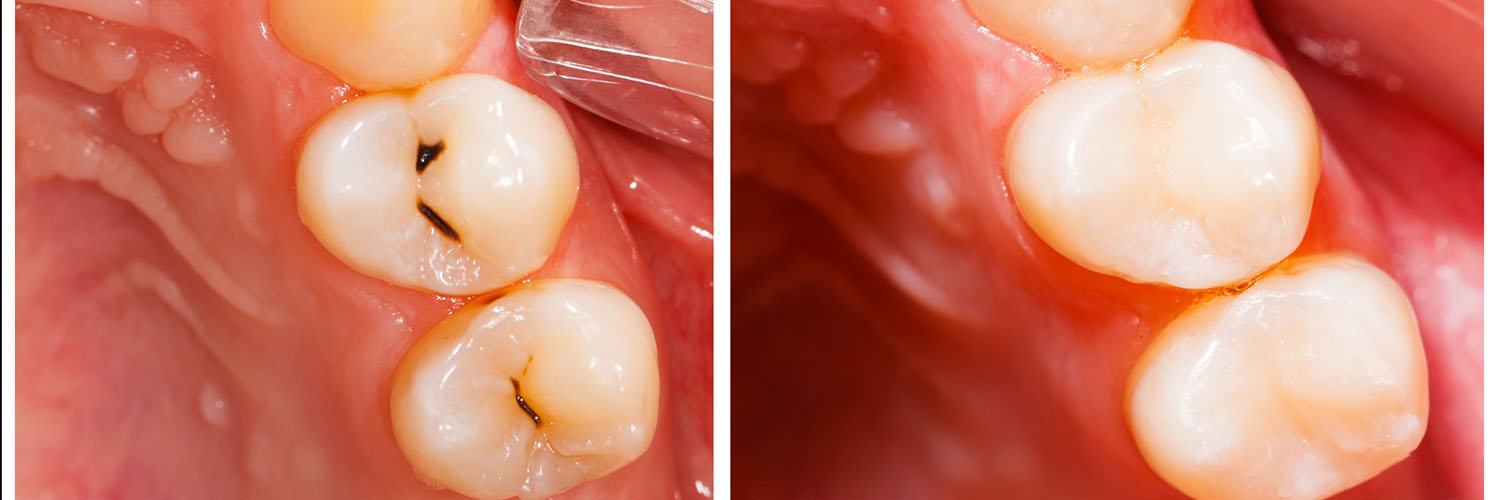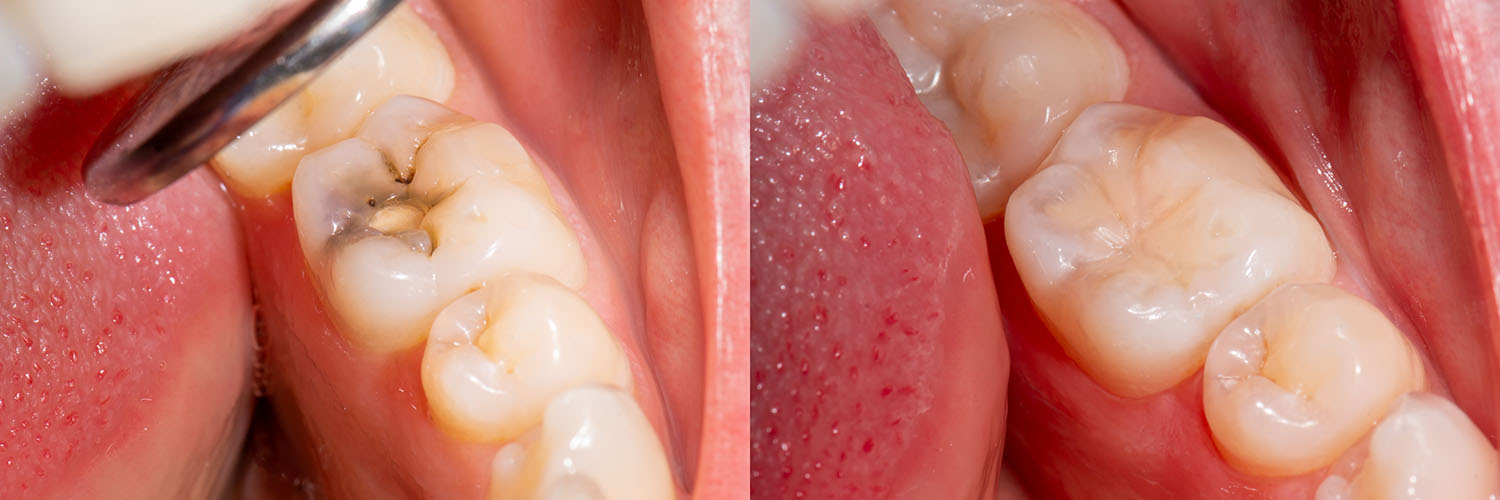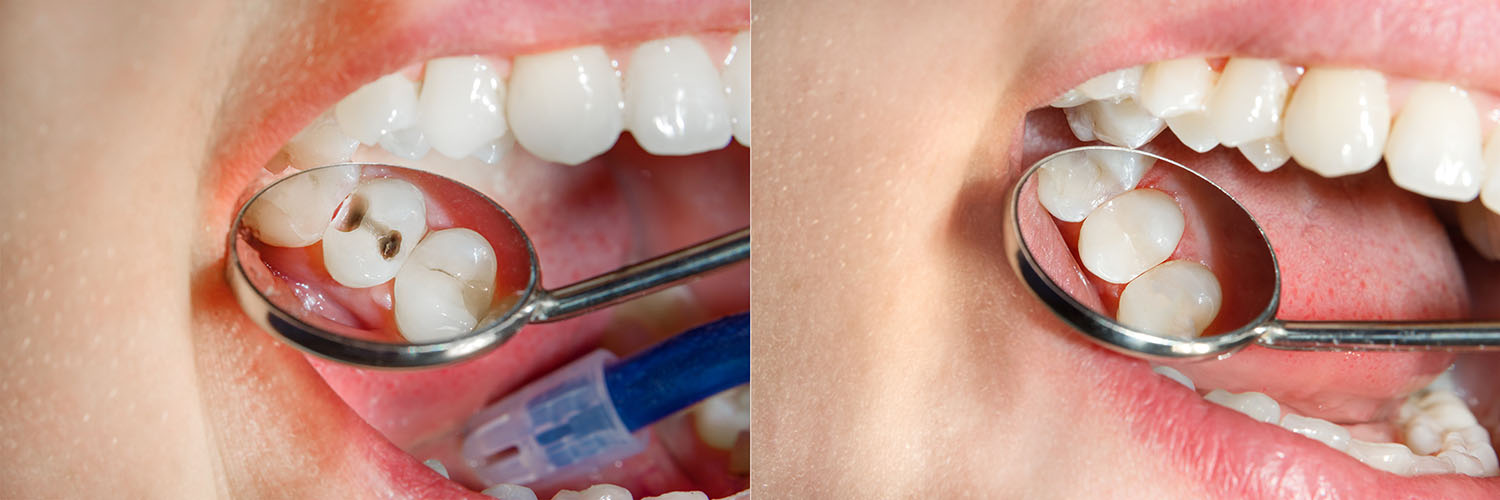
A dental filling does more than merely plug a hole. When decay or minor damage removes healthy tooth structure, a properly placed filling restores the tooth’s shape and function so you can chew, speak, and smile without discomfort. Modern restorations are designed to blend with your natural teeth while reinforcing the remaining enamel and dentin to prevent further breakdown.
Cavities remain one of the most common reasons patients visit the dentist, and timely intervention with a filling stops decay from progressing into more serious problems such as root infection or fractures. Treating a cavity early typically preserves more natural tooth structure and allows for a conservative restoration that can last for many years with appropriate care.
At Smiles Dental at Reston Town Center, our goal is to offer restorative solutions that balance durability with appearance. We use contemporary materials and techniques to provide predictable results with patient comfort in mind, and we take the time to explain why a filling is recommended and what to expect during and after treatment.
Attempts at repairing damaged teeth date back thousands of years, but modern restorative dentistry took shape in the 19th and 20th centuries with the introduction of metal alloys and, later, tooth-colored materials. Early restorations emphasized strength and longevity, while contemporary approaches prioritize aesthetics, biocompatibility, and minimally invasive techniques.
Today’s dentists have a wider selection of materials that meet both functional and cosmetic needs. That evolution has made it possible to match a restoration to the location of the tooth, the patient’s bite and habits, and long-term oral health goals—rather than forcing a one-size-fits-all solution.
Every filling begins with a careful evaluation: we assess the extent of decay, the condition of surrounding teeth and gum tissue, and any bite issues that could affect the restoration. This diagnostic process helps us choose the most appropriate material and technique so the repaired tooth performs well and looks natural.
We prioritize patient comfort throughout the procedure, using modern anesthesia techniques and clear communication so you feel informed and relaxed. If a patient is anxious about dental treatment, we discuss options for additional comfort measures, including dental sedation when appropriate.

Not all filling materials are the same, and each has advantages depending on where the cavity is and what the patient values. Some materials prioritize wear resistance for back teeth that handle chewing forces, while others focus on cosmetic blending for front teeth. Choosing the right option depends on clinical factors as well as your aesthetic preferences.
Advances in dental materials science have produced restorations that bond to tooth structure, reduce the need for extensive preparation, and offer improved longevity. Your dentist will weigh factors such as the size of the cavity, the tooth’s location, bite forces, and whether neighboring teeth have restorations when recommending a material.
For many patients, a tooth-colored restoration provides a balance of function and appearance. However, some clinical situations still benefit from stronger indirect restorations or materials with a long track record in posterior teeth. We’ll discuss the choices and help you select the restoration that best fits your needs.
Resin composites are a popular tooth-colored option composed of a plastic matrix and finely ground glass or ceramic fillers. They are available in multiple shades for a close match to your natural enamel and are often preferred in visible areas for their aesthetic appeal.
Composite fillings bond directly to the tooth, which can strengthen the remaining tooth structure and often requires removing less healthy tissue during preparation. While composites are resistant to normal chewing forces, they may be more susceptible to staining or wear over many years compared with some indirect restorations.
Amalgam has a long history of reliable use in dentistry due to its durability and ability to withstand strong chewing forces. It is typically reserved for larger posterior restorations where longevity and strength are primary concerns.
Because amalgam is metallic and visible, many patients and clinicians now reserve it for areas where appearance is less of a consideration. When chosen for the right indications, amalgam remains a robust and effective option.
Glass ionomer materials bond chemically to tooth structure and release fluoride over time, which can be beneficial for low-risk areas or for pediatric patients. Their ease of placement and chemical properties make them useful for restorations at the gum line, temporary repairs, or for baby teeth that will be lost naturally.
These materials are less wear-resistant than composites or ceramics, so they are typically used in situations where heavy chewing forces are not expected or where a temporary or protective restoration is indicated.
Ceramic restorations are created outside the mouth in a dental laboratory or via in-office milling, then bonded into place. They offer excellent wear resistance, stain resistance, and a very lifelike appearance, making them an attractive choice for larger cavities or when substantial tooth structure needs rebuilding.
Because these are indirect restorations, they typically require two visits—one for preparation and impression or scan, and another for bonding the finished piece. Their durability and aesthetics make them a strong option when conservation and appearance are priorities.
Gold restorations are highly durable and biocompatible, with a long history of predictable clinical performance. They are especially useful in certain posterior situations where longevity and precision fit are paramount.
Due to shifts in patient preferences and material cost, gold is less common today but remains a viable option when its unique properties are clinically advantageous.

When treating a cavity, the goal is to remove decay, preserve as much healthy tooth as possible, and restore the tooth so it looks and functions well. Your appointment usually begins with a careful examination and, if necessary, imaging to determine the extent of the lesion and plan the restoration.
Most routine fillings are completed under local anesthesia so the tooth and surrounding tissues are numb for the procedure. With modern anesthetic techniques you should feel little to no discomfort during the work. Depending on the chosen material and the size of the cavity, the filling may be placed directly in one visit or prepared for an indirect restoration that will be bonded later.
We use gentle, precise techniques to remove only the damaged tissue and to shape the tooth so the restoration bonds securely. After placement, we check and refine your bite and polish the restoration to ensure comfort and a natural feel. For patients who feel anxious about dental care, our team will review dental sedation options that can help you remain calm and comfortable.
Immediately after a filling, it is normal to experience temporary numbness and minor sensitivity. Numbness typically fades within a couple of hours; during that time, avoid chewing on the numb side to prevent accidental injury. A mild temperature or pressure sensitivity can persist for days to weeks as the tooth settles.
If you notice a persistent bite high spot, sharp edges, or increasing sensitivity, contact our office so we can evaluate and make small adjustments if needed. Proper oral hygiene—brushing twice daily, flossing, and regular checkups—helps extend the life of any restoration and reduces the risk of new decay around the margins.
Certain habits, such as clenching or chewing hard objects, can place extra stress on restorations and shorten their lifespan. If you grind or clench your teeth, ask about protective options. Our office will discuss follow-up care and expectations for replacement or repair when a restoration reaches the end of its useful service.
If you have questions after treatment or concerns about a recent filling, our team at Smiles Dental at Reston Town Center is available to help you understand next steps and maintain a healthy, comfortable smile. Please contact us for more information.


If the pleasure of eating a delicious bowl of ice cream or sipping a soothing cup of tea gets overshadowed by dental pain that makes you wince; it's time to contact our office. As skilled providers of care, we'll determine what's causing your discomfort and perform the treatment required to alleviate your symptoms and get you back on the road to oral health.
Cavities develop because of an infectious process that causes progressive damage to tooth structure. Despite starting as a pinpoint defect on the outermost enamel layer of your tooth, untreated dental decay progressively compromises more and more healthy tooth structure as it works its way to the inner layers of your tooth.
Yes, you can still develop tooth decay on other surfaces of the tooth, around the margins of an old filling, or in fewer instances, recurrent decay underneath it. For this reason, it's essential to maintain excellent oral hygiene, a diet low in sugary beverages and sweets, and be sure to visit our office for routine checkups and care. While tooth decay is second only to the common cold in frequency, it's almost entirely preventable.
We value the time and comfort of our patients. If cavities are located on adjacent teeth, or in the same section of your smile, it may be possible to treat more than one tooth during your visit. However, how much is done each visit depends on several factors. We keep our patients well informed and tailor every treatment plan and visit to address their unique needs.
Addressing concerns on the presence of elemental mercury in silver fillings, the American Dental Association (ADA), The Center for Disease Control and Prevention (CDC), the FDA, and the World Health Organization have all stated that amalgam restorations do not pose a risk to health. However, individuals with allergies or sensitivities to the metals in dental amalgam are advised to pursue other restorative options.
Dental fillings are performed under local anesthesia to help ensure your comfort throughout the entire procedure. The involved tooth remains completely numb for the extent of your visit. Within one or two hours after the procedure is completed, the local anesthetic will gradually wear off, and normal sensations return.
A tooth-colored composite filling is fully hardened and set by the end of your visit. However, we may advise you to wait a couple of hours until the local anesthesia has completely worn off. This advice is to help ensure you don't accidentally bite your lip, cheek, or tongue while still numb.
The lifetime of a dental filling varies depending on the type of material used. While popular dental materials can last a decade or more with proper care, they can degrade over time, wear down, or even break. When this happens, you may experience some tooth sensitivity, a jagged edge, or a loose or dislodged piece of filling material. Whatever the case may be, it's essential to get the filling replaced before the tooth sustains further damage or other consequences arise. Beyond taking good care of your smile to help ensure the longevity of your fillings, our office regularly checks the status of your existing fillings as part of a routine checkup exam.
Dental fillings are an essential investment that serves to preserve and protect the health of your smile. With that said, how much a filling costs depends on the number of surfaces of the tooth involved and the filling material that is used. Amalgam restorations are the most economical. While tooth-colored composite fillings have a slightly higher cost, they offer the added benefits of being metal-free and much more aesthetically pleasing. Ceramic fillings, inlays, and onlays are more expensive than the preceding options but provide outstanding, long-lasting, and natural-looking results.
Dental insurances typically cover the cost of dental fillings. While we work with you to maximize your insurance benefits, there may still be an out-of-pocket expense. At the office of Smiles Dental at Reston Town Center, we strive to help you begin care without any additional financial stress or delay.
Dental fillings repair teeth that have been damaged by decay or minor trauma by restoring shape, function and structural support. A properly placed filling seals off the cavity to prevent bacteria from advancing deeper into the tooth and helps you chew and speak comfortably. Modern restorations are designed to blend with surrounding enamel while preserving as much healthy tooth structure as possible.
Treating decay early with a filling reduces the likelihood of more invasive treatment such as root canal therapy or extraction. Prompt restoration also helps maintain proper bite relationships and reduces the risk of fractures to weakened teeth. Regular dental exams and X-rays let your dentist detect cavities before they grow large enough to require more complex care.
Common filling materials include resin (composite) fillings, dental amalgam, glass ionomer cement, ceramic inlays/onlays and precious metal restorations such as gold. Each material offers a different balance of aesthetics, wear resistance and durability, so the clinical situation often determines the best choice. Composites are tooth colored and bond to enamel, amalgam is highly durable for heavy chewing areas, and ceramics provide excellent longevity and lifelike appearance for larger restorations.
Glass ionomer materials chemically bond to tooth structure and release fluoride, making them useful in certain pediatric or root surface situations, while gold and ceramic restorations are typically lab fabricated for strength and precision. Indirect options such as inlays and onlays are made outside the mouth and bonded in place when a larger portion of the tooth needs rebuilding. Your dentist will explain the trade-offs between appearance, longevity and conservation of tooth structure for each option.
The choice of filling material depends on several clinical factors including the size and location of the cavity, the tooth's role in chewing, the patient's bite and any history of grinding or clenching. Aesthetic priorities and biocompatibility concerns are also considered, along with how much healthy tooth must be removed to prepare the restoration. Diagnostic imaging and a careful clinical exam guide the decision to ensure the chosen material supports long-term function.
We review these considerations and discuss the recommended options so you understand the reasons behind the choice and what to expect from the restoration. Conserving healthy tooth structure and achieving a predictable, long-lasting result are primary goals in material selection. If an indirect restoration is indicated, your dentist will outline the steps and expected timeline for fabrication and placement.
A filling appointment usually begins with an exam and any necessary X-rays to determine the extent of decay and plan the restoration. Local anesthesia is commonly used so you should feel little to no discomfort while decay is removed and the tooth is prepared. For direct restorations such as composite fillings the material is placed and cured in layers, contoured to the natural anatomy and polished for a smooth finish.
If an indirect restoration like a ceramic inlay or onlay is recommended, the appointment includes tooth preparation, an impression or digital scan, and placement of a temporary restoration followed by bonding of the final piece at a later visit. Your dentist will check and refine your bite and discuss any immediate aftercare instructions. When anxiety is a concern, options for additional comfort measures can be reviewed with the dental team.
It is common to experience temporary sensitivity to temperature, pressure or sweet foods after a filling as the tooth adjusts and the nerve calms down. Numbness from local anesthesia typically wears off within a few hours, while mild sensitivity can persist for days or several weeks; this usually resolves on its own. If sensitivity worsens or persists beyond a reasonable healing period, contact your dentist so the restoration and surrounding tissues can be evaluated.
Longer term sensitivity can be related to high spots in the bite, marginal gaps, or recurrent decay, and these issues are often correctable with a simple adjustment or repair. Good oral hygiene and routine dental exams help identify problems early and protect the restored tooth. If you have a history of toothache or deep decay, your dentist will monitor the tooth more closely after restoration.
Fillings are ideal for small- to medium-sized cavities when sufficient healthy tooth structure remains, but larger defects, extensive fractures or significant loss of cusp structure often require an indirect restoration. Crowns are recommended when the tooth needs full coverage to restore strength and prevent future fracture, while inlays and onlays are conservative lab-fabricated options for rebuilding larger portions of the tooth without full crown preparation. The decision depends on the amount of remaining tooth, functional demands and the long-term prognosis for the tooth.
Your dentist will explain the benefits and limitations of each approach and how they relate to preserving natural tooth structure and function. Indirect restorations generally require two visits and are cemented or bonded in place for enhanced durability. When a tooth has been weakened by large decay or a root canal, a crown is often the most predictable long-term solution.
Dental amalgam has a long history of clinical use and is valued for durability in posterior teeth, and major health organizations consider it a safe option for most patients. Concerns about mercury content have led many clinicians and patients to prefer tooth-colored alternatives, but amalgam remains a clinically effective choice in appropriate cases. Dentists evaluate patient-specific factors and regulatory guidance when recommending restoration materials.
Tooth-colored resin composites, ceramic inlays/onlays and glass ionomer materials are widely used alternatives that offer improved aesthetics and avoid metallic restoratives. These alternatives vary in strength and wear properties, so your dentist will recommend the option that best matches the location of the restoration and your oral health needs. When material selection involves medical considerations, the dental team will discuss suitable options and any necessary precautions.
Many restorative materials are appropriate for children, but the choice often depends on the tooth involved, the child's age, cooperation level and the expected lifespan of the primary tooth. Glass ionomer cements are frequently used in pediatric dentistry because they bond to tooth structure, release fluoride and can be placed quickly in some situations. Composite resins are also commonly used where aesthetics or durability are priorities and the child can tolerate the procedure.
Behavior management and minimally invasive techniques are important when treating younger patients, and the dental team will select materials and methods that minimize discomfort and chair time. Primary teeth restored with temporary materials may be monitored and replaced as needed until natural exfoliation, while permanent teeth receive restorations intended for longer service. Regular preventive care and fluoride use help reduce the need for future restorations in children.
Maintaining excellent oral hygiene is the foundation for prolonging the life of fillings: brush twice daily with fluoride toothpaste, floss daily and use a daily fluoride rinse if recommended. Limiting frequent sugary snacks and acidic beverages reduces the acid challenges that promote recurrent decay at restoration margins. Regular dental cleanings and checkups allow your dentist to monitor restorations for wear, marginal breakdown or secondary cavities.
Protective measures such as a night guard can prevent excessive wear in patients who grind or clench their teeth, and avoiding chewing on hard objects helps prevent fractures. If you notice changes such as roughness, discoloration at the edge of a filling, or new sensitivity, schedule an evaluation so small issues can be corrected before they become larger problems. Preventive treatments and timely maintenance preserve both natural tooth structure and the integrity of restorations.
Contact your dental office promptly if you experience increasing pain, persistent swelling, sharp or shooting pain, a bite that feels off, or a rough or chipped edge after a filling. While mild sensitivity and transient discomfort are common, symptoms that worsen or do not improve within a few weeks merit professional evaluation to check for high contacts, recurrent decay, or compromised margins. Any signs of infection such as swelling of the gum or face require immediate attention.
If you have concerns about a recent restoration, call Smiles Dental at Reston Town Center to arrange an assessment so the issue can be diagnosed and managed quickly. Early intervention often allows simple adjustments or repairs rather than more extensive treatment. The dental team will examine the tooth, take any necessary X-rays and recommend the appropriate next steps to restore comfort and function.

Ready to schedule your next dental appointment or have questions about our services?
Contacting Smiles Dental at Reston Town Center is easy! Our friendly staff is available to assist you with scheduling appointments, answering inquiries about treatment options, and addressing any concerns you may have. Whether you prefer to give us a call, send us an email, or fill out our convenient online contact form, we're here to help. Don't wait to take the first step towards achieving the smile of your dreams – reach out to us today and discover the difference personalized dental care can make.